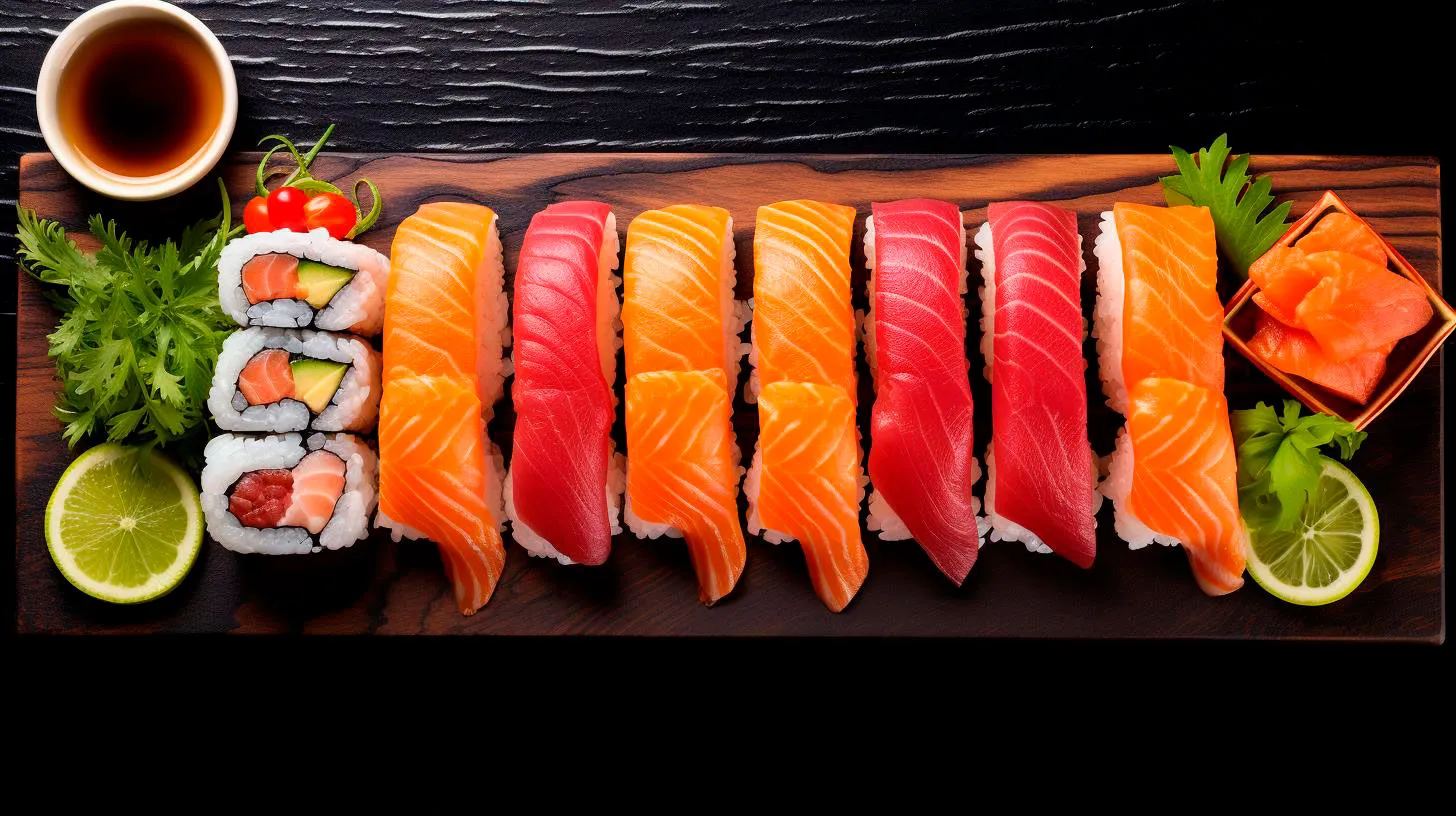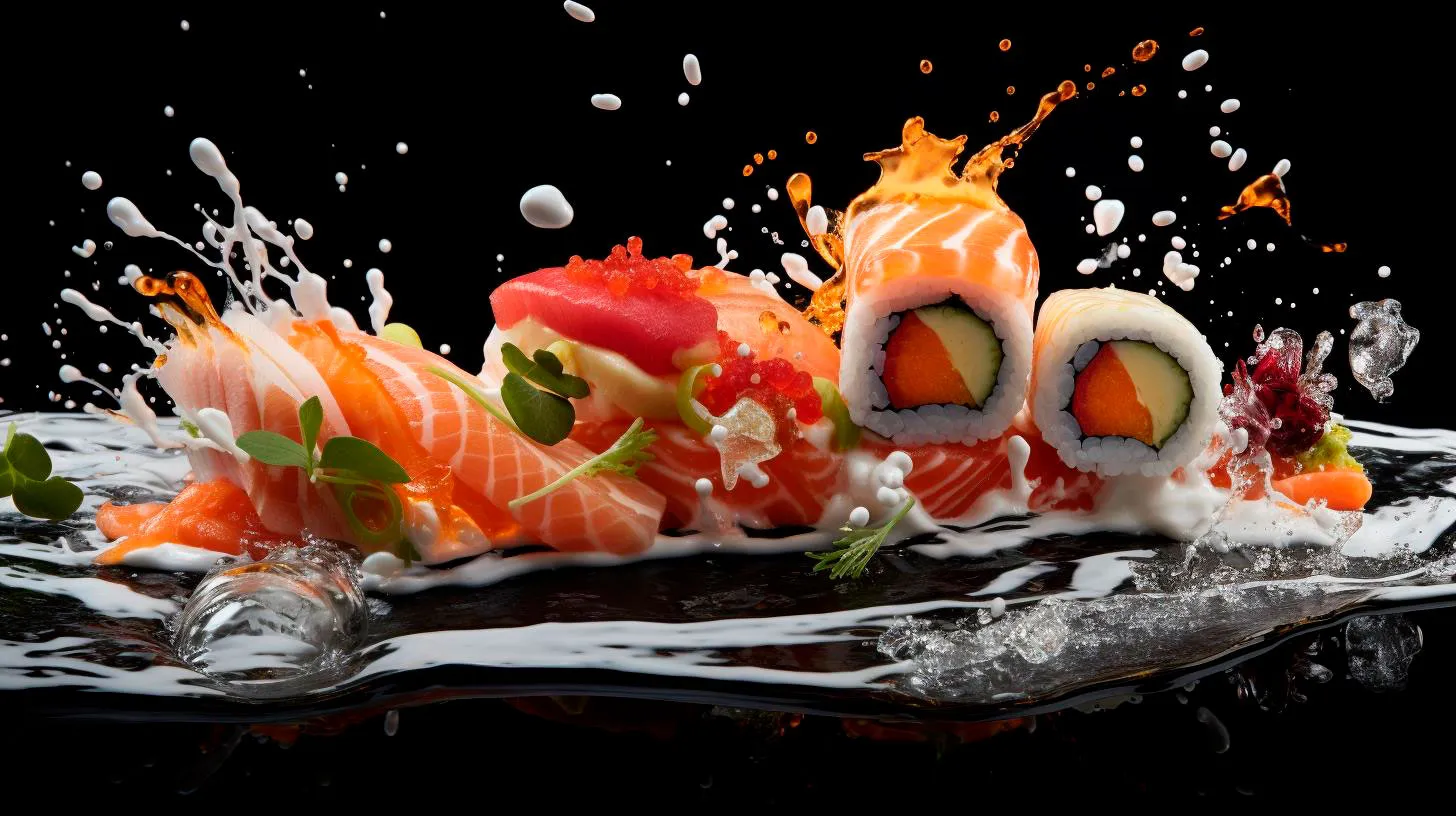Exploring How Sushi Allergies Can Extend Beyond Seafood
So, let’s explore this fascinating subject and uncover the reasons behind these unexpected allergic reactions.
The Basics of Sushi Allergies
When we think of sushi allergies, the first thing that usually comes to mind is a reaction to the seafood ingredients typically found in sushi, such as fish, shellfish, or even seaweed. However, sushi allergies can involve more than just these ingredients. The exact cause of sushi allergies can vary from person to person, but here are a few key factors to consider:
- Raw Fish: Raw fish used in sushi can contain parasites, bacteria, or other contaminants. These can cause foodborne illnesses and trigger allergic reactions.
- Soy Sauce: Soy sauce, a common condiment in sushi, contains soybeans. Some individuals have soy allergies, which can result in adverse reactions when consuming sushi.
- Wasabi: Wasabi, a spicy Japanese horseradish often served with sushi, can cause mild to severe allergic reactions in some individuals.
- Sesame Seeds: Sesame seeds are sometimes used as a garnish in sushi. Those with sesame allergies need to be cautious as even a small amount can cause a reaction.
- Gluten: Some varieties of sushi contain ingredients like tempura or imitation crab that contain gluten. Those with gluten intolerance or celiac disease should be aware of these potential allergens.
- Cross-Contamination: Cross-contamination can occur if sushi is prepared on shared surfaces or with utensils that have come into contact with allergenic ingredients.
Unveiling Uncommon Sushi Allergies
While seafood allergies are typically the most well-known, there are also a few lesser-known sushi allergies that may catch you off guard. Let’s explore some of these less common allergies:
1. Allergy to Rice
Sushi rice is a crucial component of this beloved Japanese dish. However, some individuals may experience an allergic reaction to rice, causing symptoms such as diarrhea, bloating, or stomach pain.
2. Allergy to Nori
Nori, a type of edible seaweed used to wrap sushi rolls, can trigger an allergic reaction in certain individuals. Symptoms may include itching, swelling, or difficulty breathing.
3. Allergy to Vinegar
Vinegar is commonly used to season sushi rice. While vinegar allergies are rare, they can cause symptoms like hives, itching, or an upset stomach in those affected.
Precautions and Key Takeaways
Now that we have explored sushi allergies beyond seafood, it’s essential to highlight a few precautions to take if you or someone you know has such allergies:
- Inform Restaurant Staff: When dining out, make sure to inform the restaurant staff about your specific allergies. This will help them accommodate your needs and avoid any potential cross-contamination.
- Read Ingredient Labels: When purchasing pre-packaged sushi from stores, ensure you carefully read the ingredient labels. This will help you identify any potential allergens and make informed choices.
- Consider Alternative Options: If you have multiple sushi allergies, you can still enjoy Japanese cuisine. There are several sushi alternatives available that use ingredients suitable for allergen-sensitive individuals.
Remember, it’s always crucial to consult with a medical professional or allergist to get a proper diagnosis and personalized advice based on your specific allergies.
In conclusion, sushi allergies can extend beyond seafood, encompassing various ingredients commonly found in sushi dishes. From fish and soy sauce to sesame seeds and rice, it’s essential to be aware of potential allergens and take necessary precautions. By doing so, sushi lovers can continue to indulge in this culinary delight without compromising their health or enjoyment.
That’s all for today, folks! Stay tuned for more exciting tech-related topics, and remember to share this article with your fellow sushi enthusiasts. Until next time!
Unraveling Cross-Reactivity When Sushi Allergies Become a Concern
Sushi allergies, specifically the issue of cross-reactivity, can make dining out a nerve-wracking experience. In this article, we will delve into the concept of cross-reactivity and explore how it relates to sushi allergies, along with practical tips to ensure a safe and enjoyable dining experience.
Understanding Sushi Allergies
Sushi allergies primarily arise from two major allergens: fish and seafood. Fish allergies are relatively common, affecting approximately 0.4% of the global population. On the other hand, seafood allergies, which encompass a broader range of ocean-dwelling creatures like shellfish (e.g., shrimp, crab, lobster), affect around 2% of individuals worldwide. The proteins present in fish and shellfish can trigger an adverse immune response in susceptible individuals.
Cross-Reactivity: The Culprit
Cross-reactivity occurs when an individual who is allergic to one substance experiences an allergic reaction when exposed to a different but structurally similar substance. In the case of sushi allergies, this means that if you are allergic to a specific type of fish or seafood, you might also react to other similar species.
For instance, a person with a salmon allergy might also experience symptoms when consuming other types of fish, such as trout or mackerel. Similarly, individuals with a shellfish allergy may react to various crustaceans, including shrimp, lobster, and crab.
The Risk of Cross-Reactivity in Sushi
When it comes to sushi, cross-reactivity can complicate the dining experience even further. Sushi rolls often contain a combination of different types of fish and seafood, making it difficult to identify potential allergens. Additionally, sushi chefs often handle different fish and seafood varieties using the same utensils, increasing the risk of cross-contact and triggering an allergic reaction.
Managing Sushi Allergies: Key Takeaways
While sushi allergies and cross-reactivity can be daunting, there are steps you can take to navigate this culinary challenge safely. Here are some key takeaways to keep in mind:
- Know your allergies: If you suspect a fish or shellfish allergy, consult an allergist for a proper diagnosis. Identifying the specific allergens you react to is crucial in managing your allergies.
- Communicate your needs: Inform the sushi chef and waitstaff about your allergies when dining out. It’s important to communicate clearly to ensure the necessary precautions are taken to avoid cross-contamination.
- Read menus carefully: Take your time to read the menu thoroughly, paying attention to ingredients and potential cross-reacting substances. If uncertain, consult with the staff regarding safe options.
- Consider vegetarian options: If you have severe allergies, opt for vegetarian sushi rolls. Vegetable-based rolls are a delicious and allergy-safe alternative that eliminates the risk of cross-reactivity with fish or shellfish.
- Bring your own utensils: To minimize the risk of cross-contact, consider bringing your own utensils if dining out is a frequent occurrence.
By following these precautions, you can decrease the chances of an allergic reaction and enjoy sushi without worry. Remember, your health should always be a priority, and with the right approach, you can savor the flavors of sushi while managing your allergies effectively.
In conclusion, sushi allergies, particularly cross-reactivity, can present challenges for individuals with fish and seafood allergies. Understanding the concept of cross-reactivity and taking necessary precautions is essential to ensure a safe dining experience. Communicate your allergies, read menus carefully, and consider vegetarian options to minimize the risk of cross-contact. By being proactive and well-informed, you can continue to indulge in the wonderful world of sushi while keeping your health intact.
Understanding Cross-Reactivity: Exploring Allergies Beyond Sushi
In this article, we will delve into the concept of cross-reactivity, explore its implications, and shed light on how it goes beyond the realm of sushi.
What is Cross-Reactivity?
Cross-reactivity is a phenomenon in which an allergic reaction is triggered by one substance, but similar substances also activate the immune system. This means that even if you are allergic to a specific allergen, there is a chance you may also react to other allergens that share similar protein structures.
For instance, let’s say you have a known allergy to shellfish. Cross-reactivity might mean that you can also experience allergic reactions when exposed to other types of seafood such as shrimp, crab, or lobster.
- Key Takeaway: Cross-reactivity occurs when an allergic reaction extends beyond the original allergen, triggering similar reactions to other substances.
Common Cross-Reactivities
Understanding common cross-reactivities is essential to managing allergies effectively. Here are some notable cross-reactivities that can go beyond the dinner table:
1. Pollen-Food Syndrome
Pollen-Food Syndrome, also known as Oral Allergy Syndrome, is a common cross-reactivity between specific pollens and certain fresh fruits and vegetables. If you are allergic to birch pollen, for example, you may experience itchiness and swelling in your mouth or throat when consuming apples, peaches, or cherries, as these fruits share similar allergenic proteins with birch pollen.
- Feature: Pollen-Food Syndrome is often associated with the consumption of raw or uncooked foods.
- Advantage: Cooking or processing foods can often break down allergenic proteins, reducing the likelihood of a reaction.
2. Latex-Fruit Syndrome
Latex-Fruit Syndrome involves an allergic reaction to certain fruits, particularly those with a latex-like protein structure. For individuals allergic to latex, consumption of fruits such as bananas, avocados, kiwis, or chestnuts can lead to symptoms like itching, hives, or even anaphylaxis.
- Feature: Latex-Fruit Syndrome is commonly seen in individuals who work with latex products such as gloves or in healthcare settings.
- Advantage: Identifying latex allergies and avoiding cross-reactive fruits can help prevent severe reactions.
3. Shellfish Cross-Reactivity
Shellfish allergies are well-known, but cross-reactivity expands the list of potential triggers. If you are allergic to one type of shellfish, such as shrimp, you may also react to other crustaceans like crab or lobster.
- Feature: Shellfish allergies are often lifelong, and reactions can range from mild to severe, including anaphylaxis.
- Advantage: Accurate identification of the specific allergen can help in avoiding potentially cross-reactive shellfish and preventing allergic reactions.
Conclusion
Understanding cross-reactivity is crucial for allergy management. It helps individuals with known allergies identify potential triggers beyond their initial allergen, allowing for a more comprehensive approach to avoiding allergic reactions.
Remember, allergies can extend beyond common culprits like sushi, and cross-reactivity can occur in various forms. Recognizing the signs, managing your diet, and working closely with healthcare providers are key steps in navigating the complex world of allergies.
- Key Takeaway: Cross-reactivity can lead to unexpected allergic reactions and it’s important to be aware of potential triggers beyond your primary allergen.
Stay informed, understand your body, and don’t let allergies sideline you from enjoying life to the fullest!
When Sushi Allergies Trigger Reactions to Surprising Foods
The Rise of Sushi Allergies
In recent years, there has been a noticeable increase in reported cases of sushi allergies. This may be attributed to several factors, including heightened awareness, improved diagnostic techniques, and the globalization of the sushi industry. Allergies to sushi commonly involve fish and shellfish, which are staple ingredients in many sushi dishes.
According to a study conducted by the Food Allergy Research & Education (FARE) organization, seafood allergies account for 90% of all allergic reactions to food. Additionally, approximately 2.3% of the global population is estimated to be allergic to seafood, with countries such as Japan, Norway, and Spain experiencing higher rates.
Surprising Foods That May Trigger Reactions
Sushi allergies do not stop at seafood alone. People with these allergies need to be cautious and aware of potential cross-reactivity with other foods. Cross-reactivity occurs when proteins in different but related foods have similar structures, leading to an allergic response.
Here are some foods that individuals with sushi allergies may need to avoid:
- Wasabi: Known for its distinct spicy flavor, wasabi is often served alongside sushi. However, it contains compounds similar to those found in mustard and can trigger allergic reactions in individuals sensitive to mustard.
- Seaweed: Used in many sushi rolls, seaweed can cause allergic reactions in individuals with seafood allergies. This may be due to cross-reactivity between different types of seafood proteins.
- Soy Sauce: A ubiquitous condiment in sushi, soy sauce contains soy proteins that can lead to allergic reactions in individuals with soy allergies.
- Rice Vinegar: While rice vinegar is a key ingredient in sushi rice, some individuals may experience allergic reactions due to cross-reactivity with other grains or yeast.
It’s essential to remember that allergies can vary from person to person, and individuals should consult with medical professionals to determine their specific allergens and the best course of action.
Key Takeaways and Precautions
Understanding sushi allergies and their potential cross-reactivity is crucial for both individuals with known allergies and those working in the food service industry. Here are some key takeaways to bear in mind:
- Seafood allergies account for the majority of food allergy cases, making it important to be aware of potential allergens in sushi and related foods.
- Cross-reactivity can occur, leading to unexpected allergic reactions to ingredients such as wasabi, seaweed, soy sauce, and rice vinegar.
- Consulting with medical professionals and undergoing allergy testing is essential for accurate identification of allergens and to ensure proper management.
- For those with sushi allergies, it’s crucial to inform restaurant staff about allergens to avoid cross-contamination and to identify safe meal options.
- Creating awareness among individuals, food service professionals, and communities helps in minimizing the risks associated with sushi allergies.
By staying informed and taking necessary precautions, individuals with sushi allergies can enjoy their meals without compromising their health and well-being. Remember, responsible food choices and awareness are key to a safe and enjoyable dining experience.



